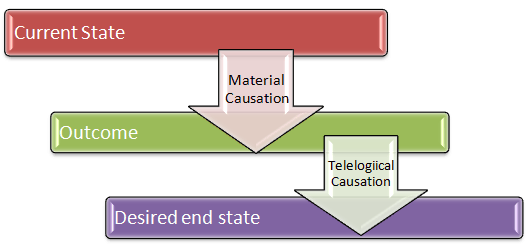This post is chapter 7 of the book 'The Opposable Mind' written by
Roger Martin. You can read the high level review of the book in THIS POST. Please read it before you read this post.
Read Chapter 1, Chapter 2, Chapter 3, Chapter 4 , Chapter 5 and Chapter 6 of the book.
This penultimate chapter of the book focuses on the tools that the integrative thinkers use. The tools are:
Declarative reasoning works through deductive and inductive logic. Deductive logic works by establishing a framework and then applying that framework to solve a problem. for example, mammals are animals with warm blood and procreate via live birth. So all animals that meet these two criteria are mammals.
Inductive logic infers general rule from empirical observations and draws conclusion on what is and what isn't true. When we see the sun rising from the east every day, we conclude that Sun always rise in the east.
Both the above do not account for the idea of invention - the idea of what could be. Generative reasoning uses a third form of logic called abductive logic. Since abductive logic generates a totally new model, it is all called generative reasoning. Integrative thinkers consider generative thinking as both conceptually legitimate and practical. Generative reasoning facilitates trial and error.
Causal modelling is the second tool of integrative thinkers. Sophisticated causal modelling is a crucial underpinning for causality and architecture. As discussed previously in the causality step, the thinker must consider non-linear and multi-directional causal links between subject variables.
We are natural model builders. many a time we are not even aware that we are using models. When it comes to causal modelling, two forms of causation are important. First is the material causation, which says that under certain circumstances X causes Y to happen.
The second form of causation, known as teleological causation, connect the way things are currently to the way they should be, also called the desired state. For a causal modeller, material and teleological causation connect the way things are to their desired end state.
How do we know that the causal model that we designed is robust enough? A technique known as system dynamics (a theory of mapping the activity of complex systems) holds that the results of our decisions are so often disappointed because either,
Read Chapter 1, Chapter 2, Chapter 3, Chapter 4 , Chapter 5 and Chapter 6 of the book.
This penultimate chapter of the book focuses on the tools that the integrative thinkers use. The tools are:
- Generative Reasoning
- Causal Modelling
- Assertive Inquiry
Declarative reasoning works through deductive and inductive logic. Deductive logic works by establishing a framework and then applying that framework to solve a problem. for example, mammals are animals with warm blood and procreate via live birth. So all animals that meet these two criteria are mammals.
Inductive logic infers general rule from empirical observations and draws conclusion on what is and what isn't true. When we see the sun rising from the east every day, we conclude that Sun always rise in the east.
Both the above do not account for the idea of invention - the idea of what could be. Generative reasoning uses a third form of logic called abductive logic. Since abductive logic generates a totally new model, it is all called generative reasoning. Integrative thinkers consider generative thinking as both conceptually legitimate and practical. Generative reasoning facilitates trial and error.
Causal modelling is the second tool of integrative thinkers. Sophisticated causal modelling is a crucial underpinning for causality and architecture. As discussed previously in the causality step, the thinker must consider non-linear and multi-directional causal links between subject variables.
We are natural model builders. many a time we are not even aware that we are using models. When it comes to causal modelling, two forms of causation are important. First is the material causation, which says that under certain circumstances X causes Y to happen.
The second form of causation, known as teleological causation, connect the way things are currently to the way they should be, also called the desired state. For a causal modeller, material and teleological causation connect the way things are to their desired end state.
How do we know that the causal model that we designed is robust enough? A technique known as system dynamics (a theory of mapping the activity of complex systems) holds that the results of our decisions are so often disappointed because either,
- We overlooked important causal relationships, or,
- We misread causal relationship usually by assuming them to be linear and unidirectional.
The primary focus of system dynamics is one sort of causal relationship. Multi-directional feedback loop.
One great tool for developing generative thinking is by using 'Radical Metaphors'. One dices a metaphor to describe the problem and builds a model around that metaphor. Metaphor tools help integrative thinkers in two ways. One, it helps thinkers conceive of the situation at hand in a way that is conducive to creating a new model.
Radical metaphors also help with keeping a coherent whole in mind while honing individual parts.
Assertive inquiry is the third tool for the integrative thinker. It is used to explore opposing models. Assertive inquiry helps unearth more salience and more unperceived causal relationships. Assertive inquiry involves a sincere search for other views and tries to fill gaps in understanding. It seeks a common ground between conflicting models.
Assertive inquiry promotes generative reasoning and causal modelling. It enables generative reasoning by breaking down conflicting models into pieces that can be reconciled into something better than either of the conflicting models. It also produces more robust causal modelling by enlisting more minds to explore and map the material and teleological connections that under-grid conflicting models

No comments:
Post a Comment